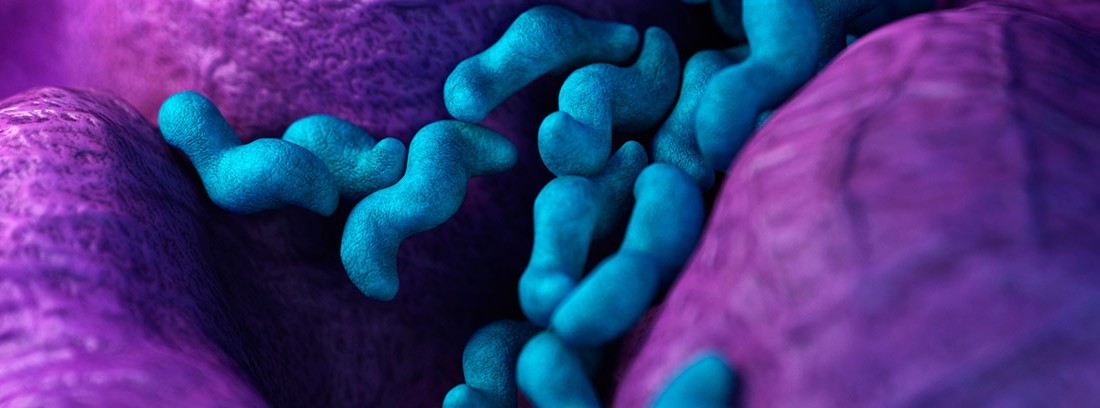Campylobacter infections: symptoms, contagion and treatment

Campylobacteriosis is one of the main causes of intestinal disease of food transmission in humans, as or more frequent than salmonellosis. When we talk about campylobacterosis we mean a disease transmitted to humans by animals (zoonoses) or products of animal origin that are contaminated. Bacteria of the genus Campylobacter live in the intestines of many animals intended for consumption such as poultry, cattle, pigs, sheep and in companion animals such as dogs and cats and, during slaughter, if the faeces come into contact with the meat, they are produces the food contamination.
Contagion and causes of infectious transmission
The main route of transmission is through food such as raw or undercooked meat and unpasteurized milk. Even water can be a source of infection if it is contaminated and infects agricultural products intended for human consumption, leading to one. However, the most frequent cases of infection occur by chicken consumption.
Campylobacter bacteria, when ingested through contaminated food, infect the lining of the intestine and even in some more serious cases they can penetrate and infect other parts of the body. For campylobacterosis to occur, the ingested dose of bacteria is usually low, an ingestion of 500-800 germs Even so, they are usually mild infections that do not require treatment, except fluid and electrolyte replacement. But in some cases, where the person already suffers from a serious illness or is immunosuppressed or in very young children, it can be fatal.
How a Campylobacter infection manifests
The period of incubation of disease after infection usually ranges from 2 and 10 days and symptoms usually last between 3 and 6 days. On some occasions, prior to enteric symptoms, a few flu-like symptoms (general malaise, headache and weakness) that usually last a day. This is followed by the most severe symptoms, where diarrhea is the main manifestation. It is usually watery and often bloody. The most common risk associated with diarrhea is dehydration, but in some cases the infection can evolve and reach the blood causing bacteremia or presence of bacteria in the blood, hepatitis, and even abortions in pregnant women. Even in a small number of cases, other complications such as reactive arthritis, with inflammation in the joints, and neurological disorders such as Guillain Barre syndrome or autoimmune disorder with polio-like paralysis
It also usually courses with abdominal pain, fever, and headache. Sometimes vomiting also appears, although it is not usually a characteristic symptom.
Campylobacter treatment
Habitually does not require treatment and only dehydration should be controlled through the replacement of fluids and electrolytes, but in invasive cases, when bacteria invade the cells of the intestinal mucosa and damage the tissues, penetrating and infecting other parts of the body, the infection should be treated with an antibiotic. To achieve the definitive diagnosis, if Campylobacter infection is suspected, a stool culture or stool culture that will allow to identify if there is growth of the microorganism. If bacteremia or passage of bacteria into the blood is suspected, a request for a blood culture to perform the most specific antimicrobial treatment.
How to prevent infections?
Being a contagious infection, to prevent it it is necessary to follow good hygiene habits like hand washing and a food safety when processing any food in order to avoid possible cross contamination. This microorganism is sensitive to a temperature above 55ºC and at low pH values. Therefore, proper cooking of meat, pasteurization of milk and chlorination of water destroy this microorganism. Here are some steps to take to prevent infections by Campylobacter in the home as it is more difficult to control:
- Cook food completely at a suitable temperature, particularly poultry, and keep food at safe temperatures after cooking.
- Never wash Add water to raw chicken before cooking, as it can spread germs around the kitchen (counter, utensils, and cutting boards).
- Separate raw and cooked foods to avoid pollution crusade.
- Drink the pasteurized milk And, if we are in another country, especially in developing countries, choose packaged and pasteurized milk and juices.
- Always consume drinking water that has been tested and approved for human consumption.
- Wash your handss before preparing any food and after handling raw meat, especially poultry.
- Clean up cutting boards and utensils that have come into contact with raw meat using hot soapy water and then sanitizing.
- The main route of transmission is through foods such as raw or undercooked meat, and unpasteurized milk. The most frequent cases of infection are from chicken consumption.
- Usually does not require treatment and should only be control dehydration through fluid and electrolyte replacement.
- This microorganism is sensitive to a temperature above 55ºC and at low pH values. For this reason, cooking meat, pasteurization of milk and chlorination of water destroy this microorganism.
Deborah Blasco Nutrition Nurse Advance Medical consultation
(Updated at Apr 14 / 2024)